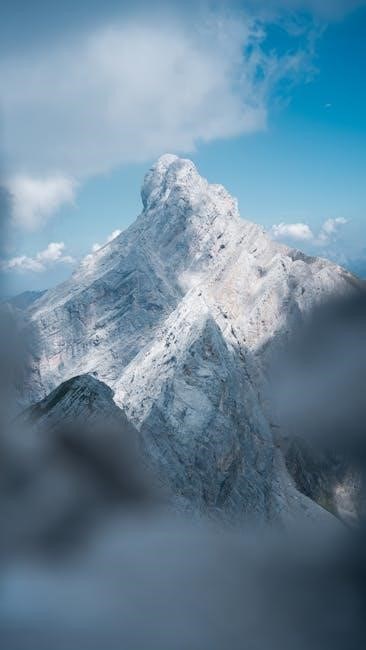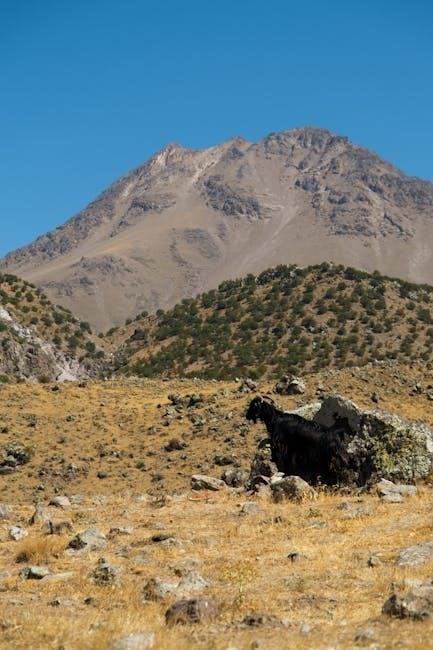
mountain dulcimer chord chart pdf
The mountain dulcimer chord chart PDF is a vital tool for musicians, offering a comprehensive guide to chords, tunings, and finger placements for this unique instrument.

1.1 What is a Mountain Dulcimer?
The mountain dulcimer is a traditional stringed musical instrument originating from the Appalachian region of the United States. It typically features three or four strings and is played by plucking or strumming with a pick or noter. Known for its sweet, resonant sound, the dulcimer is often associated with folk music. Its construction includes a hourglass-shaped body and a fretted neck, making it accessible to players of various skill levels. The mountain dulcimer is highly versatile, supporting both simple melodies and complex arrangements. Its portability and ease of learning have made it a favorite among musicians for centuries. This instrument’s charm lies in its simplicity and rich tonal qualities.
1.2 What is a Chord Chart?
A chord chart is a visual guide that illustrates how to play chords on a musical instrument. For the mountain dulcimer, it typically shows the placement of fingers on the fretboard to produce specific chords. Chord charts are essential for both beginners and experienced players, as they provide a quick reference for learning and mastering chord shapes. They often include fret numbers, string notations, and diagrams to clarify finger placement. A chord chart can be especially useful for the mountain dulcimer, given its unique tuning and string setup. It helps musicians identify chord structures and transitions, making it easier to learn and play songs efficiently. Chord charts are often available as downloadable PDFs for convenient access.
1.3 Why Use a Mountain Dulcimer Chord Chart PDF?
A mountain dulcimer chord chart PDF is an invaluable tool for musicians due to its portability and clarity. PDFs are easy to download and carry, allowing players to access chords anytime, anywhere. They provide a clean, organized layout of chord shapes, fret numbers, and string notations, making them simple to read. PDF charts are also easily printable, enabling musicians to have a physical reference during practice. Additionally, PDFs are universally compatible with most devices, ensuring accessibility for everyone. This format is particularly beneficial for beginners, as it offers a structured learning aid, while also serving experienced players as a quick reference guide.

Understanding the Mountain Dulcimer Chord Chart Layout
The layout organizes chords clearly, showing finger placements, fret positions, and string assignments, making it easy to visualize and play chords effectively on the dulcimer.
2;1 How to Read the Chord Chart
The chord chart is a visual guide that maps chords onto the dulcimer’s fretboard. Each chord is represented by a diagram showing the strings and frets. Numbers indicate where fingers should press the strings. Open strings are often marked with a ‘0’. The chart uses symbols to denote chord shapes, making it easy to replicate finger placements. Players can quickly identify which frets to press and which strings to play or mute. Understanding the chart’s notation helps in mastering chord shapes and transitions. This visual system simplifies learning and ensures accurate chord reproduction, making it an essential tool for players of all skill levels.
2.2 Fret Numbers and String Notations
Fret numbers on the mountain dulcimer chord chart indicate which frets to press on each string. Typically, the chart displays strings from top to bottom, with numbers showing the fret positions. A ‘0’ denotes an open string played without pressing the fret. Each string may be labeled with its note name or tuning pitch, helping players identify their role in the chord. Understanding these notations ensures accurate chord formation. For example, in DAD tuning, the bass string is D, the middle string is A, and the treble string is D. This system helps players quickly locate the correct frets and strings, making chord playing straightforward and precise.
2.3 Tuning and String Setup
The mountain dulcimer is typically played in open tunings, such as DAD, DAC, or DAA, which simplify chord playing. The standard setup includes three strings: a bass string (thickest), a middle string, and a treble string (thinnest). Tuning is critical for proper chord formation, as the chord chart is designed around these specific tunings. The bass string is usually tuned to D, while the middle and treble strings vary based on the tuning. Proper tuning ensures that chords sound clear and accurate. Beginners should use a tuner or reference pitch to set their strings correctly, as this setup directly affects the chord shapes and overall playability.
Types of Chords Included in the Chart
The chart includes major, minor, seventh, diminished, and augmented chords, providing a comprehensive guide for various musical styles and harmonic needs.
3.1 Major Chords
Major chords are foundational in music, consisting of a root note, a major third, and a perfect fifth. On the mountain dulcimer, these chords produce a bright, uplifting sound. The chart includes common major chords like C, D, E, F, and G, each with clear finger placements. Players can quickly identify these chords due to their straightforward structure. Major chords are versatile, fitting various genres, from folk to modern compositions. The PDF chart visually organizes these chords, making it easier for dulcimer enthusiasts to learn and play them effectively. This section simplifies the process of mastering major chords, enhancing both practice and performance.
3.2 Minor Chords
Minor chords add depth and emotion to music, consisting of a root note, a minor third, and a perfect fifth. On the mountain dulcimer, minor chords create a melancholic yet beautiful sound. The chord chart includes common minor chords such as Cm, Dm, Em, and Am, with precise finger placements. These chords are essential for players aiming to diversify their musical expressions. The PDF chart organizes minor chords clearly, making them accessible for practice and performance. Whether playing traditional folk tunes or contemporary pieces, mastering minor chords expands the dulcimer’s expressive range. This section helps players learn and utilize minor chords effectively in their music.
3.3 Seventh Chords
Seventh chords add complexity and depth to music, consisting of a root, third, fifth, and seventh note. On the mountain dulcimer, these chords create rich, resonant tones perfect for enhancing songs with emotional nuance. The chord chart includes common seventh chords like C7, D7, and G7, with clear finger placements. Seventh chords are versatile, suitable for various genres, from folk to blues. They offer a way to add harmonic interest and expand musical expression. For players seeking to diversify their sound, mastering seventh chords is essential. The PDF chart simplifies learning these chords, making them accessible for practice and performance. Explore seventh chords to elevate your dulcimer playing.
3.4 Diminished and Augmented Chords
Diminished and augmented chords offer unique tonal qualities, adding tension and color to music. A diminished chord consists of a root, minor third, and diminished fifth, while an augmented chord includes a root, major third, and augmented fifth. The mountain dulcimer chord chart PDF includes these chords, such as C°, D°, and C+. These chords are less common but provide emotional depth and complexity. Diminished chords create a sense of tension, while augmented chords offer a bright, unsettling feel. Both are versatile for various musical styles and can enhance arrangements. The chart provides clear finger placements, making these chords accessible for exploration and experimentation in your dulcimer playing.
Tunings for the Mountain Dulcimer
The mountain dulcimer uses various tunings to suit different musical styles. Common tunings include DAD, DAC, and DAA, each offering unique tonal qualities. The chord chart PDF provides finger placement guides for these tunings, enhancing playability and versatility for all skill levels. This section explores the most popular tunings and their applications.
4.1 DAD Tuning
DAD tuning is the most common tuning for the mountain dulcimer, with strings pitched to D, A, and D from high to low. This tuning offers a rich, full sound and is ideal for beginners, as it simplifies playing simple chords and melodies. The chord chart PDF provides clear finger placement guides for DAD tuning, making it easier to learn and play. This tuning is versatile, accommodating both traditional and modern music styles, and is a popular choice among dulcimer players of all skill levels. It serves as a foundation for exploring more complex tunings and techniques.
4.2 DAC Tuning
DAC tuning is another popular option for the mountain dulcimer, with strings tuned to D, A, and C. This tuning offers a bright, crisp sound and is often preferred for its harmonic richness. It is particularly well-suited for playing chords and melodies in keys that align with the C string’s pitch. The chord chart PDF provides specific finger placements for DAC tuning, ensuring players can easily transition between chords. While slightly less common than DAD tuning, DAC offers unique tonal possibilities and is favored by many intermediate and advanced players for its versatility in various musical genres and arrangements.
4.3 DAA Tuning
DAA tuning, with strings tuned to D, A, and A, is a less common but unique setup for the mountain dulcimer. This tuning creates a warm, resonant sound, particularly suited for playing in keys that emphasize the A string. The doubled A string adds depth and richness to chords and melodies. While it may require adjustments for some chord shapes, the chord chart PDF provides clear guidance for navigating this tuning. DAA tuning is ideal for players seeking a softer, more mellow tonal quality and is often used in folk and traditional music to evoke a haunting or introspective atmosphere.

Benefits of Using the Mountain Dulcimer Chord Chart PDF
The chord chart PDF enhances accessibility, offering clear visuals and organized layouts. It supports players of all skill levels, fostering learning, creativity, and structured musical growth effectively.

5.1 Simplifies Learning for Beginners
The mountain dulcimer chord chart PDF simplifies learning by providing a visually organized layout of chords. Beginners can quickly identify finger placements and string interactions, reducing confusion. The clear diagrams and concise instructions make it easier to grasp basic chord shapes. By breaking down complex chords into manageable steps, the chart helps new players build confidence. It also introduces foundational concepts like tuning and string setup, ensuring a solid understanding of the instrument. This structured approach minimizes the learning curve, allowing beginners to focus on technique and musical expression from the start. It’s an invaluable resource for those new to the mountain dulcimer.
5.2 Enhances Creativity for Intermediate Players
The mountain dulcimer chord chart PDF offers intermediate players a wealth of inspiration for creative exploration. By providing advanced chord variations and less common chord voicings, the chart encourages experimentation with unique sounds. Players can explore alternate tunings and chord substitutions, adding depth to their music. The chart also highlights movable chord shapes, enabling intermediate players to craft intricate melodies and harmonies. This resource fosters improvisation and composition, helping players develop their own style. With its comprehensive chord library, the PDF becomes a toolkit for Intermediate musicians to push boundaries and express their creativity freely, taking their playing to new artistic heights.
5.3 Provides Structure for Advanced Techniques

The mountain dulcimer chord chart PDF serves as a foundational guide for advanced players seeking to refine their skills. It offers detailed finger placements and chord transitions, allowing for seamless execution of complex techniques. Advanced players can benefit from exploring barre chords and intricate tunings, all mapped out clearly in the chart. The structured layout simplifies the learning process, enabling musicians to focus on nuanced playing styles. This resource is particularly valuable for those aiming to master intricate compositions and expand their musical versatility, ensuring a polished and professional sound in their performances, while fostering continuous musical growth.
How to Use the Chord Chart for Practice

Use the chart to identify common chords, practice smooth transitions, and build muscle memory. Regular practice with the chart enhances familiarity and improves playing efficiency.

6.1 Finding Common Chords for Songs
Identify common chords used in your favorite songs by referencing the chord chart. Most songs rely on a core set of chords, which the chart organizes clearly. Match the chords to the song’s key and structure. Use the chart to find chord shapes and finger placements quickly. For example, many folk songs use D, G, and A chords, which are prominently featured. Practice switching between these chords to build familiarity. This step is essential for learning new songs efficiently and expanding your repertoire. Regular practice with the chart will help you master the most frequently used chords in mountain dulcimer music.
6.2 Practicing Chord Transitions
Mastering smooth chord transitions is key to playing cohesive songs on the mountain dulcimer. Use the chord chart to identify the most common chord changes for your repertoire. Start by practicing transitions between closely related chords, such as D to G or C to D. Focus on finger placement and movement efficiency to minimize pauses. Gradually increase your speed as you build confidence. Pay attention to maintaining a steady rhythm and clean notes during switches. Regular practice will improve your dexterity and fluidity. Incorporate a metronome to refine timing and ensure seamless transitions. Consistent practice will enhance your overall performance quality and musicality.
6.3 Building Muscle Memory
Building muscle memory is essential for fluent mountain dulcimer playing. Start by practicing chords slowly, focusing on precise finger placement. Use the chord chart to guide your fingers to the correct frets and strings. Repetition is key—practice each chord multiple times until your fingers move instinctively. Begin with short practice sessions, gradually increasing duration as comfort grows. Incorporate simple exercises like switching between chords in a specific order. Over time, your hands will develop muscle memory, allowing you to play chords effortlessly. This foundation will enable you to focus on rhythm, timing, and expression. Consistent practice ensures lasting progress and mastery.

Advanced Techniques with the Chord Chart
Unlock advanced techniques to elevate your mountain dulcimer skills. Explore movable chord shapes, barre chords, and intricate fingerpicking patterns. These methods expand your musical versatility and creativity, enabling complex compositions and richer sounds. Regular practice of these techniques will enhance your overall playing ability and open up new possibilities for expression and improvisation.
—
7.1 Movable Chord Shapes
Movable chord shapes allow you to play chords across the fretboard. Learn these shapes to adapt chords to different keys, adding versatility to your playing;
7.2 Exploring Chord Progressions
Experiment with various chord progressions to create dynamic music. This skill helps in composing and improvising, making your performances more engaging and polished.
7.3 Incorporating Barre Chords
Barre chords extend your chord vocabulary. Mastering them enables you to play complex chords, enhancing your ability to play in multiple keys and styles.
Movable chord shapes are essential for versatility on the mountain dulcimer. These shapes can be slid up or down the fretboard to play chords in different keys without altering the finger pattern. By mastering these shapes, players can adapt chords to various tunings, such as DAD or DAC, and explore a wider range of musical keys. Movable shapes simplify chord transitions and enhance creativity, allowing for more dynamic and varied performances. Regular practice of these shapes strengthens finger dexterity and expands your musical repertoire, making them a valuable tool for both intermediate and advanced players seeking to refine their technique and expression.
Exploring chord progressions with the mountain dulcimer chord chart PDF opens up endless creative possibilities. By understanding how chords relate harmonically, players can craft meaningful sequences that enhance their music. Common progressions like I-IV-V or I-vi-IV-V are easily identifiable using the chart. This tool helps musicians experiment with different keys and tunings, fostering a deeper connection to the music. For songwriters, chord progressions provide a foundation for composing original pieces. Regular practice with these sequences also improves improvisational skills and enhances overall musical expression, making the chord chart an indispensable resource for both traditional and modern mountain dulcimer playing.
Incorporating barre chords into your mountain dulcimer playing expands your creative possibilities and enhances your musical versatility. Barre chords allow for a wider range of tonal options and can add depth to your compositions or covers. The mountain dulcimer chord chart PDF provides clear visuals for barre chord finger placements, making them easier to learn and incorporate into your repertoire. While barre chords may present a challenge initially, they can greatly expand your musical expression. Regular practice with these chords will improve finger strength and dexterity, allowing you to explore more complex and nuanced sounds on the dulcimer.

Resources for Downloading the PDF Chart
Discover trusted websites offering free and paid mountain dulcimer chord chart PDFs, ensuring access to comprehensive and accurate resources for your musical journey.
8.1 Websites Offering Free Downloads
Several websites provide free mountain dulcimer chord chart PDFs, making it easy for players to access essential resources. DulcimerTabs, Folkcraft, and The Dulcimer Shop are popular platforms offering downloadable charts. These sites often feature user-friendly interfaces and a wide range of chords and tunings. Many of these resources are created by experienced players and educators, ensuring accuracy and relevance. Additionally, forums and communities like Dulcimer Players News sometimes share free PDFs as part of their mission to promote the instrument. Always verify the quality and completeness of the charts before downloading to ensure they meet your needs.
8.2 Paid Resources for Comprehensive Charts
For those seeking detailed and high-quality mountain dulcimer chord charts, paid resources offer comprehensive guides tailored for serious players. Websites like Etsy and Amazon feature digital downloads from skilled creators, often including chord charts with multiple tunings and finger placements. Platforms like The Dulcimer Shop and Folkcraft provide premium PDFs with expanded chord libraries, perfect for advanced techniques. Additionally, educational sites like TrueFire and ArtistWorks offer paid courses that include downloadable chord charts as part of their lesson packages. These paid resources are ideal for players looking for in-depth, professionally designed materials to enhance their learning journey.
The mountain dulcimer chord chart PDF is an invaluable tool for all players, offering clear layouts and comprehensive chord options that enhance learning and creativity. Whether you’re a beginner or an advanced player, this resource provides a structured approach to mastering the instrument. By leveraging the chart, you can explore various tunings, chord progressions, and techniques, ultimately enriching your musical experience. It’s a must-have for anyone aiming to fully embrace the beauty and versatility of the mountain dulcimer.
9.1 Final Thoughts on Using the Mountain Dulcimer Chord Chart PDF
Using a mountain dulcimer chord chart PDF is a highly effective way to streamline your learning process and elevate your playing skills. Whether you’re a novice or an experienced musician, the chart provides a clear, organized method to understand chord shapes, tunings, and transitions. Its portability and ease of use make it an essential companion for practice sessions. By mastering the chords and techniques outlined in the chart, you can unlock the full potential of the mountain dulcimer and expand your musical creativity. Embrace this valuable resource to enhance your musical journey and enjoy the rich, resonant tones of this timeless instrument.